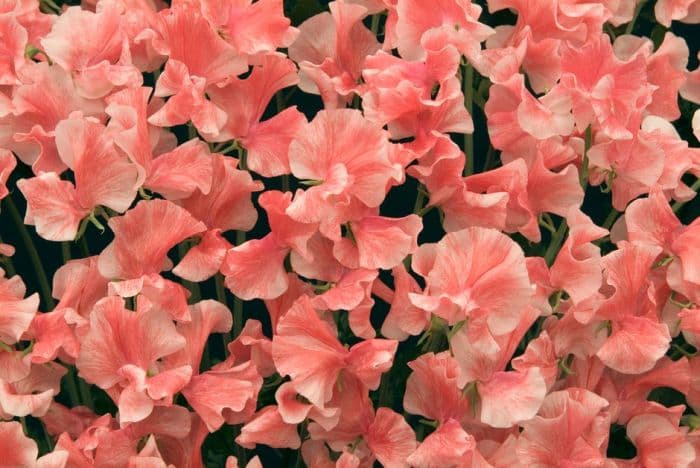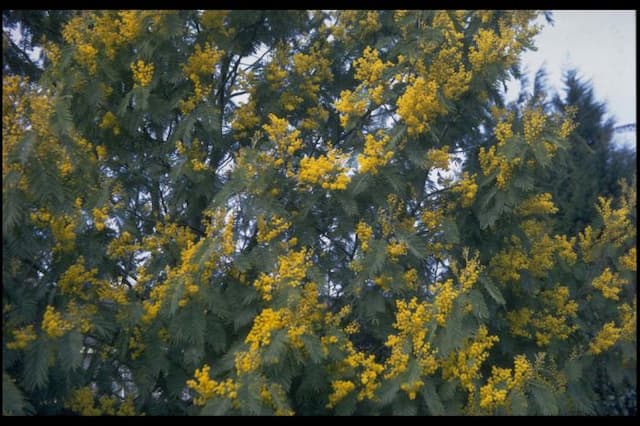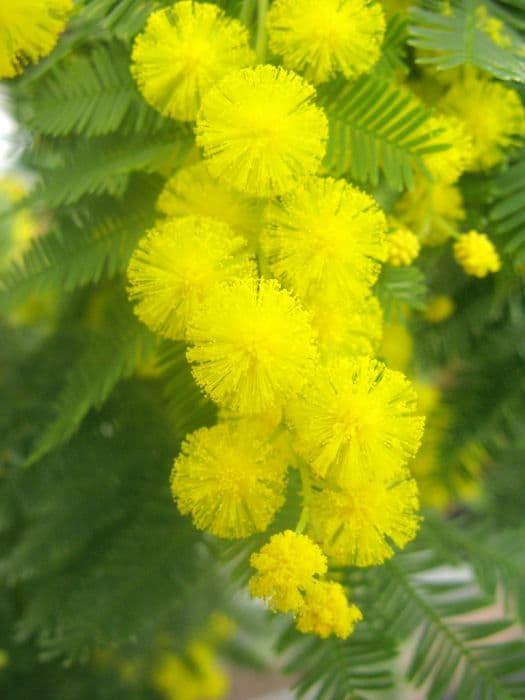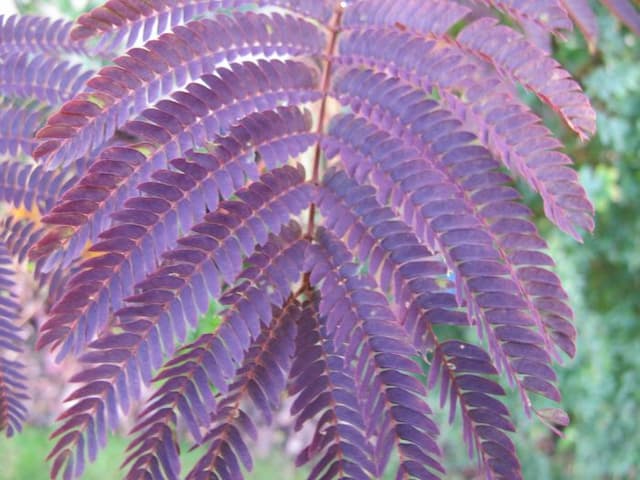Sweet pea Lathyrus odoratus 'Geoff Hughes'

ABOUT
Lathyrus odoratus 'Geoff Hughes', commonly known as sweet pea 'Geoff Hughes', boasts a graceful and vibrant appearance. This variety of sweet pea is noted for its delicate tendrils that gracefully cling and twine around supports, giving it a charmingly tendrilled habit. The stems are slender and hold an abundance of foliage, with each leaf comprising multiple small, oval-shaped leaflets that are soft to the touch. The real showstoppers of the 'Geoff Hughes' variety are its flowers. The blossoms are striking, flaunting a range of colors that can include shades of purple, pink, blue, and white, with some flowers displaying a captivating bi-color pattern. Each bloom is butterfly-shaped, with a characteristic standard, or banner, and wings, which are the broader petal sections that are elegantly ruffled and display veins of darker or contrasting hues. Adding to their allure, the flowers exude a delightfully sweet and heady fragrance that is particularly potent on warm days, attracting both human admirers and pollinators like bees and butterflies. The sweet peas' scent is often described as rich and complex, with a classic, old-fashioned character that can perfume an entire garden area. The pods that follow the flowers are also noteworthy in appearance, starting green and then maturing to a brownish tone before splitting open to release small, round seeds. These seeds carry the promise of future generations of sweet pea 'Geoff Hughes' with the same enchanting characteristics. Overall, this plant embodies a romantic garden aesthetic and is cherished for its scented, colorful blooms that epitomize the beauty of cottage-style gardens.
About this plant
 Names
NamesFamily
Fabaceae.
Synonyms
Sweet Pea, Everlasting Pea, Perennial Pea, Lathyrus.
Common names
Lathyrus odoratus.
 Toxicity
ToxicityTo humans
The common name for Lathyrus odoratus 'Geoff Hughes' is sweet pea. Sweet pea plants contain toxic chemicals known as aminopropionitrile fumarate, which can be harmful if ingested in large quantities. However, poisoning from sweet peas is uncommon as the plant is not typically consumed by humans. If large amounts of the seeds or other plant parts are ingested, it could lead to a condition called lathyrism. Symptoms of lathyrism can include weakness, lethargy, and paralysis. Chronic ingestion can result in more severe neurological effects, including convulsions and potentially death.
To pets
Sweet pea, the common name for Lathyrus odoratus 'Geoff Hughes', is considered toxic to pets, particularly to dogs and cats. If pets ingest sweet pea, they may experience symptoms such as vomiting, diarrhea, and seizures. More severe cases can lead to lethargy, tremors, and may also affect their ability to walk. It is important to prevent pets from ingesting this plant, and if suspected poisoning occurs, immediate veterinary care should be sought.
 Characteristics
CharacteristicsLife cycle
Annuals
Foliage type
Deciduous
Color of leaves
Green
Flower color
Varies
Height
6 feet (1.8 meters)
Spread
1 foot (0.3 meters)
Plant type
Climber
Hardiness zones
2
Native area
Mediterranean
Benefits
 General Benefits
General Benefits- Aesthetic Appeal: Sweet pea 'Geoff Hughes' features colorful and fragrant flowers that add beauty to gardens and landscapes.
- Attracts Pollinators: The plant is known to attract bees, butterflies, and other beneficial insects, supporting local ecosystems.
- Versatility in Landscaping: Can be used for borders, trellises, and as cut flowers for indoor arrangements.
- Ease of Cultivation: It is relatively easy to grow in a variety of climates and soil types, making it accessible to many gardeners.
- Seasonal Interest: Sweet pea 'Geoff Hughes' provides spring to early summer interest with its vibrant blooms.
- Genetic Diversity: Growing heirloom varieties like 'Geoff Hughes' helps preserve genetic variety in garden plants.
- Educational Value: An ideal plant for teaching about gardening and plant growth due to its fast-growing nature.
 Medical Properties
Medical PropertiesThis plant is not used for medical purposes.
 Air-purifying Qualities
Air-purifying QualitiesThis plant is not specifically known for air purifying qualities.
 Other Uses
Other Uses- Lathyrus odoratus 'Geoff Hughes', commonly known as sweet pea, has been used in artisanal perfume production due to its strong, sweet fragrance.
- The sweet pea flowers are often used in bridal bouquets and wedding decorations for their delicate appearance and pleasant scent.
- These flowers can be pressed and used in craft projects like homemade greeting cards or bookmarks, adding a floral touch and fragrance to paper goods.
- Some artists use sweet pea flowers as natural dyes, extracting their color to use in textiles or art projects.
- Sweet pea blossoms are sometimes crystallized with sugar and used as edible decorations for cakes and pastries.
- They can serve as an inspiration for artists and designers due to their vibrant colors and shapes, leading to sweet pea-themed artworks, textiles, and fashion items.
- In educational settings, sweet peas are used to teach children about plant biology and the life cycle of flowering plants due to their fast-growing nature.
- Hobbyist gardeners often engage in sweet pea competitions, growing various cultivars for their size, color, and fragrance to be judged at fairs and gardening shows.
- The climbing nature of sweet peas can be utilized in gardens for vertical interest; they can adorn trellises or arbors, providing a living floral display.
- Photographers and nature enthusiasts might seek out sweet pea flowers for macro photography, capturing their intricate details and structure.
Interesting Facts
 Feng Shui
Feng ShuiThe Sweet Pea is not used in Feng Shui practice.
 Zodiac Sign Compitability
Zodiac Sign CompitabilityThe Sweet Pea is not used in astrology practice.
 Plant Symbolism
Plant Symbolism- Pleasure: Known as Sweet Pea, Lathyrus odoratus 'Geoff Hughes' often symbolizes pleasure due to its sweet fragrance and delicate blooms, suggesting the enjoyment and sweet moments in life.
- Goodbye: Sweet Pea can also symbolize departure or goodbyes, as it was traditionally given to someone who was leaving or embarking on a new journey.
- Blissful pleasure: This flower additionally conveys the meaning of blissful pleasure, indicating a deeper level of happiness and contentment.
- Thank you: Sweet Pea is also associated with gratitude, making it a common choice for thank-you bouquets.
 Water
WaterSweet peas, including the variety 'Geoff Hughes', prefer to be kept consistently moist but not soggy. Depending on the weather conditions, watering once or twice a week with about 1 gallon per plant should suffice. It's best to water deeply at the base of the plant to encourage deep root growth, reducing the need for frequent watering. During hot spells or in particularly dry climates, monitoring the soil moisture regularly and increasing the watering frequency may be necessary to keep the soil from drying out completely.
 Light
LightSweet peas thrive in a location with full sun, which would be at least 6 hours of direct sunlight each day. Bountiful sunlight is crucial for vigorous growth and abundant flowering. Placing 'Geoff Hughes' sweet peas in an area with good morning exposure and some protection from intense afternoon sun can help to prevent overheating during the hottest part of the day.
 Temperature
TemperatureSweet peas, such as 'Geoff Hughes', prefer cooler climates and will flourish in temperatures between 55 and 65 degrees Fahrenheit. They are tolerant of a light frost and can withstand minimum temperatures down to slightly below 32 degrees Fahrenheit, but extended cold below this can be damaging. Sweet peas perform poorly in high heat, and temperatures consistently above 75 degrees Fahrenheit can hamper flowering and overall plant health.
 Pruning
PruningPruning sweet peas like 'Geoff Hughes' encourages stronger, bushier growth and increases flower production. Pinch out the growing tips when plants are 4 to 8 inches tall to promote branching. Regularly cutting the flowers for bouquets or deadheading faded blooms will also stimulate new growth and prolong the flowering season. The best time for major pruning is in late winter or early spring before new growth begins.
 Cleaning
CleaningAs needed
 Soil
SoilSweet Pea 'Geoff Hughes' thrives in fertile, well-drained soil with a pH between 6.0 and 7.5. A balanced mix of loam, compost, and well-rotted manure optimizes growth, ensuring adequate nutrients and moisture retention.
 Repotting
RepottingSweet Peas, being annuals, do not typically require repotting. They are usually sown directly where they are to flower, as they do not transplant well.
 Humidity & Misting
Humidity & MistingSweet Pea 'Geoff Hughes' prefers moderate humidity but is adaptable. Ensure good air circulation to minimize the risk of fungal diseases, especially in damp conditions.
 Suitable locations
Suitable locationsIndoor
Place in bright, indirect light with cool temps.
Outdoor
Plant in full sun, cool area, provide support for climbing.
Hardiness zone
2-11 USDA
 Life cycle
Life cycleSweet pea 'Geoff Hughes' begins its life as a seed, which, when sown in the soil in early spring or late winter, will germinate when temperatures are suitable, often between 55-65°F (13-18°C). After sprouting, it develops a root system and a pair of true leaves, quickly followed by vigorous vine growth, climbing if given support. As it matures, the plant will produce distinctive, fragrant flowers in the summer, which are its reproductive structures, showcasing a range of colors from the breeding program. Following pollination, typically by bees or other insects, the flowers will develop into seed pods. As the pods mature, they will eventually dry and split open, releasing seeds to the environment for dispersal. The plant is an annual, completing its life cycle within one growing season and dying with the first frosts of autumn or winter, relying on its seeds to propagate the next generation.
 Propogation
PropogationPropogation time
Spring to early summer
The Lathyrus odoratus 'Geoff Hughes', commonly known as sweet pea 'Geoff Hughes', is most commonly propagated through seed sowing. The ideal time to propagate sweet peas is in late winter or early spring, which gives the seeds a chance to establish themselves and benefit from the cooler growing conditions. To propagate, seeds are typically soaked in water for 24 hours to soften the hard outer coating. After soaking, the seeds are sown in well-draining soil at a depth of about 1 inch (2.54 cm). It's important to space the seeds about 2 to 3 inches (5 to 7.6 cm) apart and keep them in a bright, cool place. They require regular watering to keep the soil consistently moist but not waterlogged. Germination usually occurs within 10 to 14 days, at which point the seedlings can be gradually acclimated to outdoor conditions if they have been started indoors.









